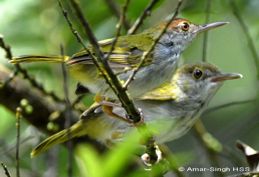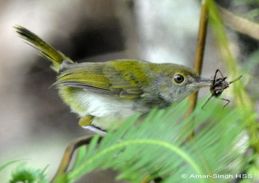A pair of adult Dark-necked Tailorbird (Orthotomus atrogularis atrogularis) was photographed in the Kledang-Sayong Forest Reserve, Perak, Malaysia feeding two juveniles (above left) on 16th September 2009.
According to Dato’ Dr Amar-Sing HSS, “Food that I saw fed to juveniles was spiders (above right) and caterpillars. The adult would get the food, with juveniles chasing close behind and calling out constantly. Some food (caterpillar) was branch swiped by the parent before presented to the juvenile. Other (like the spider) was branch swiped by the juvenile itself.
“Data on what food is taken is limited locally (Wells 2007).”
All images by Amar-Singh HSS (Dato, Dr)
Reference:
Wells, D.R., 2007. The birds of the Thai-Malay Peninsular. Vol. II, Passerines. Christopher Helm, London. 800 pp.











One Response
I meet this species before and I noticed that the body size of the juvenile is much more larger than the adult, I wonder why is this happen, because of the adult non-stop feeding ? When it become adult, it’s body size will shrink ??